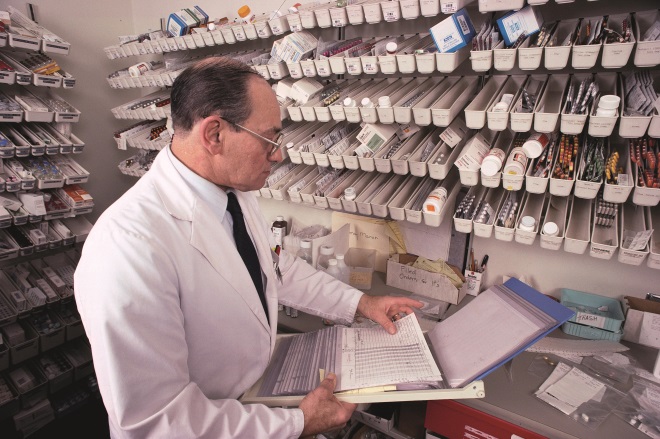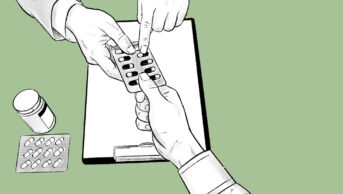
What research have you have been involved with and why it was carried out?
The North East clinical pharmacy network tries to improve clinical pharmacy practice within the North East of England. One area of focus has been the development of pharmacist prescribing.
We distributed a survey to all prescribing pharmacists working in secondary care practice in both physical and mental health. A total of 82 pharmacists responded out of 133 qualified prescribing pharmacists registered within the North East region employed by secondary care (response rate 61%). Pharmacists were asked how they were prescribing, what barriers to prescribing existed, how pharmacists monitor their effectiveness as prescribers, and how pharmacist prescribing can be developed further.
What were the most important findings?
We discovered that over three quarters of the pharmacists we asked prescribe mainly for general inpatients, with only one third of pharmacist prescribers being involved in outpatient clinics. Pharmacists are using prescribing to complement and enhance the traditional clinical pharmacy role on wards, for example, by taking ownership of the pharmaceutical issues they identify and resolving them by prescribing.
We also found that pharmacists who have been qualified prescribers for more than five years are less likely to be actively prescribing. This is because they are more likely to have progressed into a management post that does not facilitate enough patient contact time to maintain prescribing competence.
Many pharmacists stated that they found a lack of confidence, appropriate training and adequate support hindered their development as prescribers. Additionally, there was an inconsistency in how prescribing was supervised. To ensure the development of pharmacist prescribing in the future, the profession needs to address these areas.
What problems are pharmacist prescribers facing?
One major problem outlined in the survey was a lack of clarity about how pharmacist prescribers are different from other prescribers. This means that some pharmacists have limited confidence in being able to define their prescribing role and responsibilities.
Additionally, those pharmacists who stated that prescribing has allowed them to take on extra roles claimed that additional time and funding has not been allocated for these responsibilities.
Within the NHS, the perpetual challenge of lack of time and money has affected the implementation of pharmacist prescribing. Some areas and individuals who were determined to support prescribing pharmacists have found the resources for this. Others have been frustrated by the inability to develop prescribing in their own organisation. Pharmacist prescribing has therefore not developed consistently across the country.

Source: RF Corbis Value / Alamy
Pharmacists who are using their prescribing rights most effectively are able to proactively address the problem of medication errors.
How can these problems be overcome?
Within the North East region, we have attempted to define the role of pharmacist prescribers. Pharmacists prescribe for outpatients and clinic patients where there is a specific clinical need for them to do so and funding has been found to support this role. Funding can come in many forms including from internal trust business cases and external organisations, such as clinical commissioning groups and local government. For acutely ill inpatients, pharmacist prescribers complement the roles of doctors and nurses to optimise the patients’ therapy, by helping ensure medicines are prescribed accurately and appropriately.
Pharmacists who are using their prescribing rights most effectively are able to proactively address the problem of medication errors. The challenge for pharmacist prescribers is to avoid only correcting mistakes made by junior doctors, especially during the admission and medicines reconciliation processes. Pharmacists can provide education and good practice examples to other non-pharmacist prescribers to improve standards all round.
On a national level, to increase the chance of prescribing becoming embedded in practice, adequate funding needs to be identified to support the pharmacist prescribing role. Pharmacist prescribers therefore have to clearly demonstrate the clinical benefits for patients and the financial case for a pharmacist prescriber by producing evidence from research. This way, the role will continue to evolve and develop to maximise the impact pharmacists can have on patient care.
What can be done to address the lack of confidence among some pharmacist prescribers?
Achieving the prescribing qualification is only the first step and ongoing personal development is required to effectively integrate prescribing into pharmacists’ practice. The survey demonstrated that many pharmacists found the prescribing course did not prepare them for the increased responsibility of prescribing, and many lacked confidence in their clinical skills. It is essential for pharmacist prescribers to have the necessary supervision and peer support to develop their confidence in the role.
To help support pharmacists across the North East region, the clinical pharmacy network is working on a prescribing support framework, which it will be developing and piloting during 2015. The aim is to provide newly qualified pharmacist prescribers with the skills and support they need to put their prescribing qualification into practice.
The network will develop a toolkit to allow pharmacists to share good practice, implement support via supervision, and demonstrate the value of pharmacist prescribing to patient care. The overall goal is to implement a framework that will support and facilitate pharmacist prescribing as an integral part of care delivered by all pharmacists.


